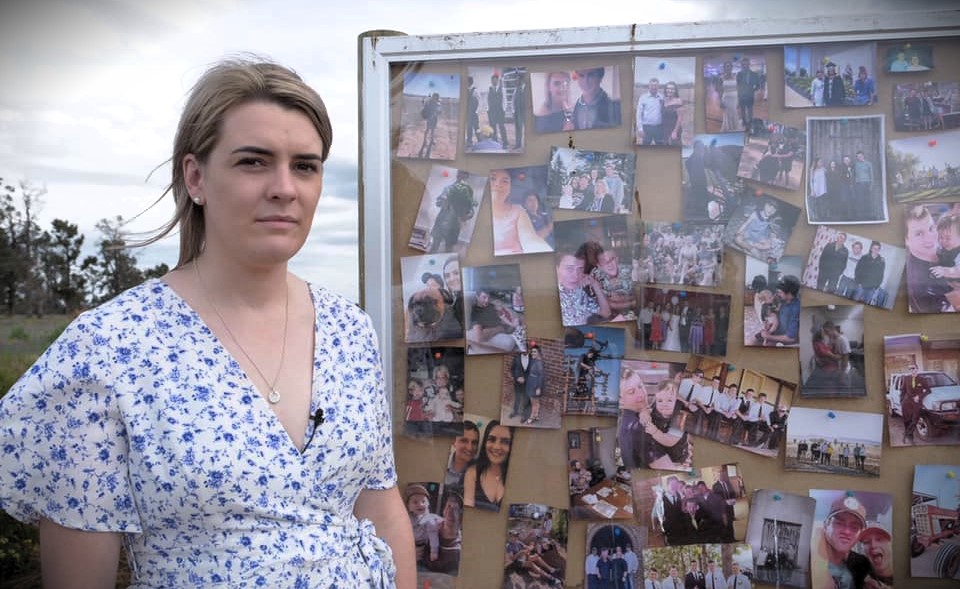
Maddie Bott, who lost her fiance in a railway level crossing collision in February 2021, says signing the federal petition would help effect changes to lighting requirements on trains throughout Australia. Photo: Maddie Bott.
A woman whose life was shattered by the death of her fiance at a railway level crossing accident near Young is urging regional residents to put their names to a federal petition to improve train lighting.
Maddie Bott has joined the National Farmers Federation in throwing their support behind The Improve Train Lighting and Level Crossing Safety Group’s nationwide call to make train lighting a legal requirement.
The petition is asking the Federal Parliament to implement legislation requiring mandatory rotating beacon lights on the front and sides of trains and rolling stock.
The Improve Train Lighting and Level Crossing Safety Group comprises 12 rural families and is led by Lara Jensen, whose brother was killed in a triple fatality at an unlit crossing in 2000 in Western Australia.
A coronial inquest into the crash found no-one in the vehicle had seen the train due to inadequate train lighting and no warning signs on the approach to the crossing.
According to Lara, 80 per cent of the 23,000 railway crossings in Australia do not have warning lights which made it essential to have adequate illumination.
She also said there was no legal requirement for Australian trains to be lit to a particular standard.
“By contrast, oversized trucks are required by law to be fitted with flashing beacon lights and all trailers must be fitted with mandatory side lighting,” she said.
“Trains are at least 15 times heavier than trucks and can be up to 1.8 km long, yet they have minimal frontal lighting and no side lighting; they remain the largest and most poorly lit vehicle on land.”
Maddie Bott has been the face of campaigning for stronger safety regulations at railway level crossings since her fiance Ethan Hunter (27), and another Grenfell man, Mark Fenton (50) were killed when their B-double collided with a freight train at a level crossing near Bribbaree, west of Young in February 2021.
“As a family with all the other families who have lost loved ones at level crossings, we want change,” she told Region.
“There are so many fingers in the pie in the rail industry which makes implementing change so hard. Each state has their own rules.”
Maddie said the Federal Government had the power to make across-the-board train illumination standards mandatory, a move recommended in multiple coronial inquest reports and backed by research and trials conducted by Monash University.
Findings from these trials, geared to help industry better understand where to focus its resources to improve train visibility and safety at regional crossings, are currently part of a review to inform a draft code expected to be presented to federal and state ministers for their consideration and approval this year.
“This issue is not going to go away; we won’t go away – so state and federal governments need to do something about these issues before more people die,” Maddie said.
“We are asking them to stop living in the 19th century and to implement them,” she said.
National Farmers’ Federation (NFF) president David Jochinke said the organisation strongly supported the families who had advocated for decades for better train illumination after they lost loved ones.
“These families have been through hell, but they don’t want sympathy, they want action,” Mr Jochinke said.
“Increased train lighting is a simple and sensible solution that will save lives on regional roads.”
Between 1 July 2014 and 31 December 2022 there were 7839 near hits, 322 collisions, 39 fatalities and 49 serious injuries at Australian level crossings.
Lara Jensen said despite decades of campaigning by families for improved lighting and multiple reports backing this, they had failed to see action.
“The changes being sought are not just technical adjustments, they are necessary steps to protect lives and prevent further tragedies at our level crossings,” she said.
“I encourage everyone interested in supporting road and rail safety to sign the petition. It would be unforgiveable not to increase train lighting to save lives.”
The closing date for signatures is 31 July.
The petition can be found here.









